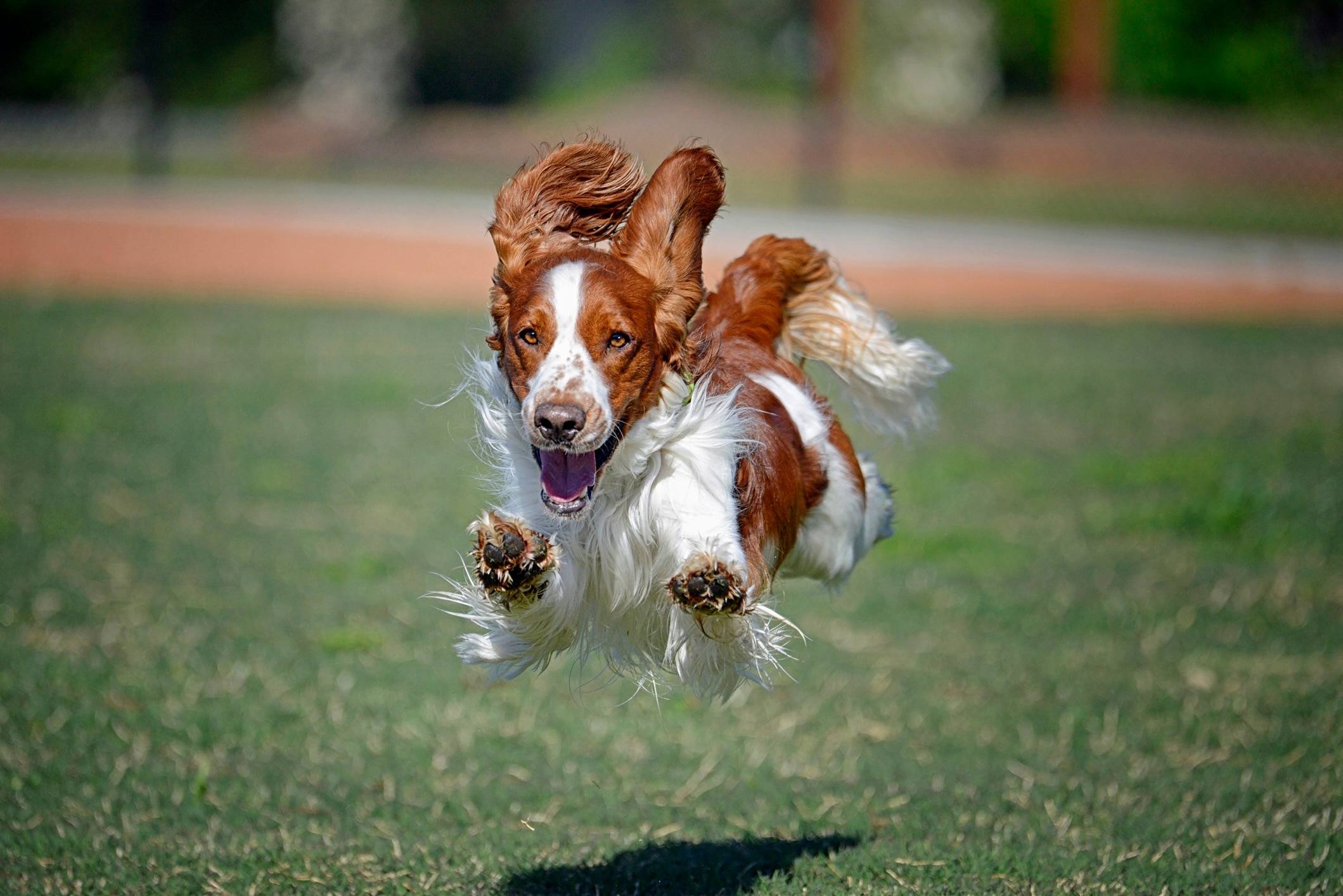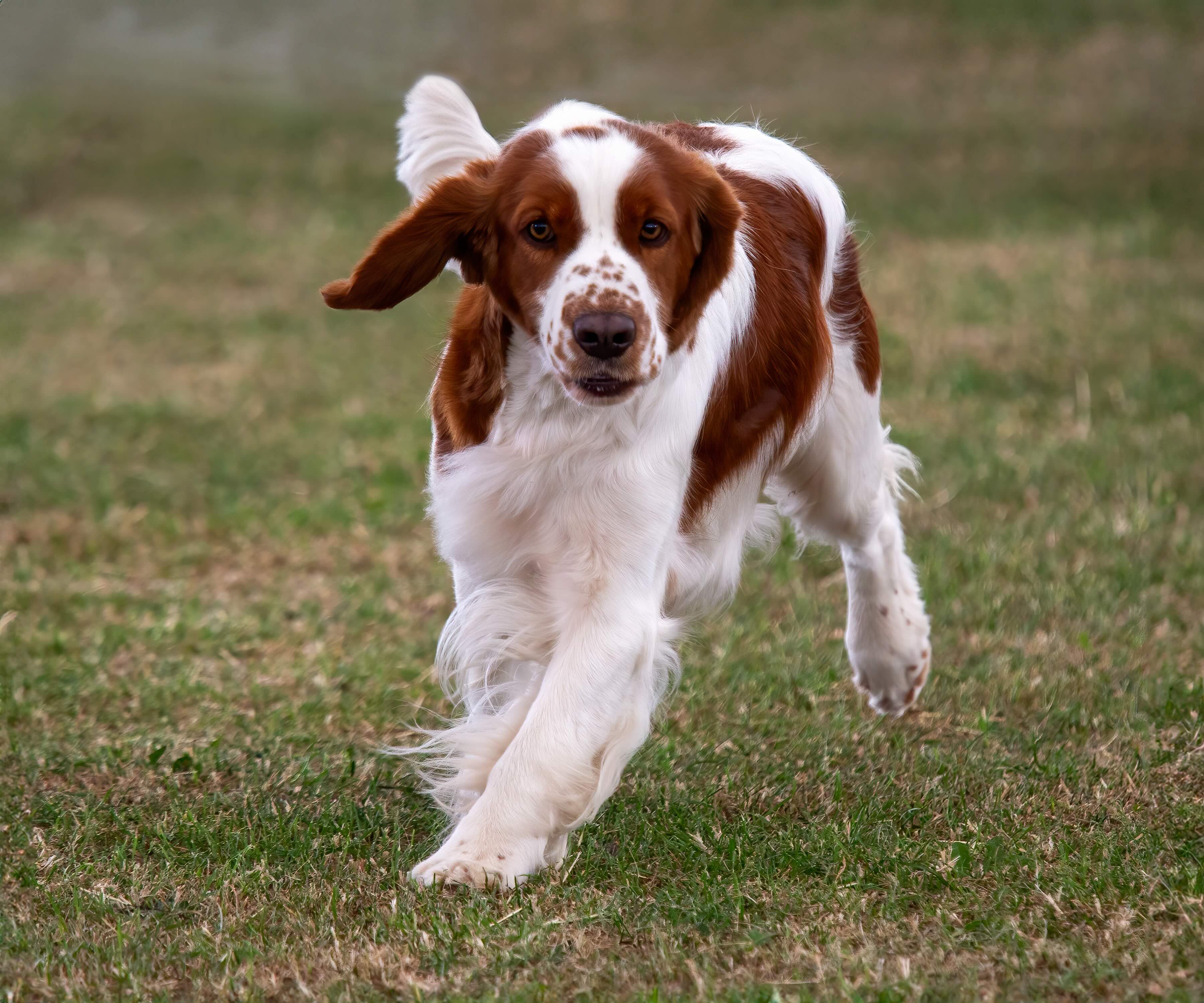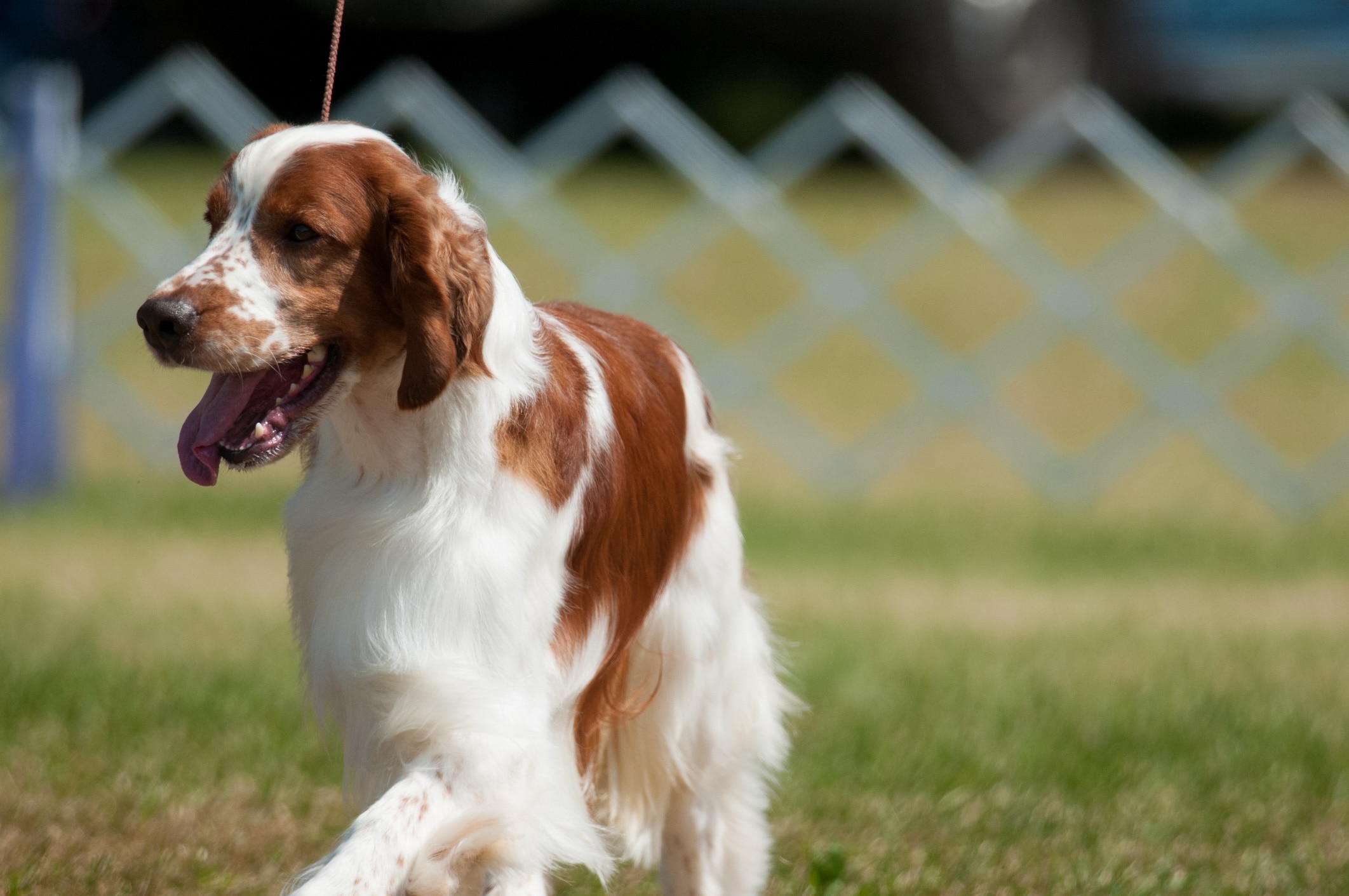Welsh Springer Spaniel
mirceax/iStock / Getty Images Plus via Getty Images
The loyal, affectionate Welsh Springer Spaniel, or Welshie, is often described as a “Velcro dog” due to their strong need for companionship. However, it’s important to note that they want this friendship to come from their family, and they can be reserved when meeting new people.
An ancient bird-hunting breed developed in Wales, active and energetic Welshies gained American Kennel Club (AKC) member status in 1906. The Welsh Springer Spaniel is described in the breed standard as being “an attractive dog of handy size … compact, not leggy, obviously built for hard work and endurance.” And indeed they are compact, ranging 35–55 pounds in weight and 17–19 inches in height.
Welsh Springer Spaniel dogs boast soft brown eyes, ears that endearingly flop and flap, and typically a docked tail. However, tail docking in dogs is a controversial practice opposed by the American Veterinary Medical Association.
Their characteristically red and white double coats of smooth fur protect them from the elements when on the job but make them particularly pleasant snuggle partners when off duty—as long as they get their daily exercise first.
Caring for a Welsh Springer Spaniel
First and foremost, Welsh Springer Spaniels need a family that is present. According to the Welsh Springer Spaniel Club of America (WSSCA), Welshies generally prefer the company of their people over other pets, though they are most likely to jell with other Welshies.
Because Welsh Springer Spaniels were bred as hunting dogs, they can follow their talented noses into trouble. That’s why all off-leash play should happen only within a securely fenced area. It’s also why Welshies might not be a good fit in homes with pet birds, bunnies, or other smaller pets.
Early socialization and consistent training is especially important for dogs like Welshies, which are prone to being reserved around strangers; they will also resort to barking when concerned or bored. To stay mentally and physically fit, Welsh Springer Spaniels need daily opportunities for exercising their brain and body.
Grooming tends to be relatively easy, though your exact routine will depend on your Welshie’s coat and lifestyle. Typically, a once-a-week brushing is all that’s needed.
Welsh Springer Spaniel Health Issues

The average Welshie lifespan is 12–15 years. Though they’re a generally healthy dog breed, make sure your Welsh Springer Spaniel breeder screens for the following health conditions.
Hip Dysplasia
Hip dysplasia is a condition in which the hip joint doesn’t develop properly, causing a looseness that eventually leads to degenerative joint disease (osteoarthritis). Mild cases are treated with interventions like weight loss, physical therapy, and anti-inflammatory drugs, but severe cases may require surgery.
Common signs of hip dysplasia include:
-
Limping
-
Reluctance to get up or jump
-
Shifting of weight to front legs
-
Loss of muscle mass in back legs
-
Hip pain
Elbow Dysplasia
Similar to hip dysplasia, elbow dysplasia happens when an elbow joint doesn’t develop as it should. It’s one of the most common causes of osteoarthritis in dog elbows.
Anti-inflammatory drugs can help with the pain and inflammation, but surgery is recommended before osteoarthritis develops.
Common signs of elbow dysplasia include:
-
Limping, especially after exercise
-
Reluctance or unwillingness to walk or exercise
-
Stiffness in the elbow joint
-
Grating or crackling sound from the elbow joint
Hypothyroidism
Hypothyroidism is a disease in which the thyroid gland produces insufficient amounts of thyroid hormones. This can lead to all kinds of symptoms, including:
-
Weight gain
-
Dry, brittle hair
-
Chronic ear infections
-
Chronic skin infections
The good news is that this condition can be managed with lifelong medication, and dogs with hypothyroidism often live long and happy lives.
Eye Problems
The Welshie is predisposed to several eye conditions, including:
-
Narrow-angle glaucoma: Glaucoma is a disease characterized by increased intraocular pressure (IOP) due to fluid production/drainage imbalance. Narrow-angle glaucoma (sometimes called closed-angle glaucoma) is more common in Welshies and describes when the iris blocks fluid drainage, causing a sudden increase in IOP that leads to acute pain and blindness.
-
Entropion: Entropion is a condition in which a dog’s eyelid grows inward, causing their eyelashes to rub against their cornea. It’s the most common eyelid abnormality in dogs.
-
Distichiasis: Distichiasis describes when an eyelash grows inside the eyelid instead of on the regular lash line. Similar to entropion, this can cause the dog’s eyelashes to rub against the cornea, resulting in irritation and ulcers to the cornea (surface of the eyeball).
What To Feed a Welsh Springer Spaniel

No two Welshies are exactly alike, so it’s important to partner with your veterinarian in choosing the best food and feeding plan for your dog. Your vet can recommend a food that meets Association of American Feed Control Officials (AAFCO) standards and is nutritionally complete for your pet’s age, size, and health history.
Always feed your dog a food that’s formulated for their life stage: puppy, adult, or senior.
How To Feed a Welsh Springer Spaniel
Most adult Welsh Springer Spaniel dogs should eat two meals a day: once in the morning and again in the evening. But because Welsh Springer Spaniel puppies have higher metabolisms than adult dogs, it’s generally best to add a midday feeding for a total of three meals.
Your vet can help you create the best feeding schedule for your dog’s age.
How Much Should You Feed a Welsh Springer Spaniel?
The label on your dog’s food packaging includes a feeding guide that will give you a general idea of how much to feed your dog, but ask your veterinarian for more accurate guidance. They will recommend food and portion sizes depending on your dog’s age, weight, body condition score, lifestyle, and health needs.
Include treats in your daily calorie count for the most accurate view into what your pet is eating. Treats should never make up more than 10% of your dog's daily calorie requirements.
Nutritional Tips for Welsh Springer Spaniels
If your Welshie is eating a complete and balanced dog food that’s AAFCO-compliant, they shouldn’t need supplementation.
However, if your Welsh Springer Spaniel is older, develops a health condition, or is at risk of a health condition, your veterinarian might recommend a dog supplement to improve their health, such as a joint supplement for hip or elbow dysplasia.
Always talk to your vet before adding anything new to your dog’s diet—including supplements.
Behavior and Training Tips for Welsh Springer Spaniels
Welsh Springer Spaniel Personality and Temperament

The WSSCA describes Welsh Springer Spaniels as loyal, affectionate, and devoted family members.
Often referred to as “Velcro dogs,” Welshies are happiest when they’re with their humans. This breed can get along well with other dogs and even cats when properly socialized, introduced, and supervised.
Welsh Springer Spaniels are active, energetic working dogs who still need “jobs” each day. If you aren’t a hunter, other forms of mental stimulation and physical exercise are just fine.
Welsh Springer Spaniel Behavior
The Welsh Springer Spaniel was originally bred to be a bird dog, and their natural instincts to chase require careful consideration. Their powerful sense of smell and strong prey drive are grounds for keeping them either on a leash or within a securely fenced area at all times. They also shouldn’t join homes with small pets like birds and bunnies for the same reasons.
Welshies are innately reserved around strangers, which often leads to barking. Boredom stemming from lack of exercise and/or companionship may also cause an increase in barking (and potentially other unwanted behaviors like chewing).
Welsh Springer Spaniel Training
During your Welsh Springer Spaniel puppy’s first four months of life, it’s important to expose them to new people, animals, sights, sounds, and situations. These first weeks are a crucial learning period for them, and socializing your Welshie can help them feel comfortable in a wide variety of settings as they grow.
Welshies are smart dogs that are easy to train with positive reinforcement. The WSSCA says most Welshie pups basically house-train themselves. No matter what you’re teaching your dog, using a positive, reward-based training approach has the triple benefit of teaching necessary skills, building the human-animal bond, and providing mental and physical exercise.
If you use treats as a reward during training, factor them into your dog’s daily calorie count. Play, favorite dog toys, and other things your Welsh Springer Spaniel enjoys can also be used as “treats” for good behavior.
Fun Activities for Welsh Springer Spaniels
-
Tracking
-
Skills training
-
Rally
Welsh Springer Spaniel Grooming Guide

The Welsh Springer Spaniel’s unique red and white coat is soft, flat, and dense enough to protect them from unsavory weather and terrain while hunting. Luckily, their impressive coats only shed a moderate amount and require very little grooming.
Skin Care
Good coat care is the key to good skin care. Regular grooming can help remove twigs, burrs, and other debris that can get caught in your Welshie’s coat and irritate their skin. It’s also a good time to check your dog for ticks they might pick up outside.
How often you bathe your dog will depend in part on your dog’s lifestyle. Keep in mind that too many baths can strip the skin of healthy oils. When you do bathe your dog, always use a dog-specific shampoo—never a shampoo meant for humans.
Coat Care
Plan on thoroughly brushing your Welsh Springer Spaniel’s coat at least once a week to keep it healthy and free from mats.
Eye Care
Welshies are prone to eye issues, so watch for signs of redness, discharge, cloudiness, or apparent vision issues. Call your vet if you have any concerns.
Ear Care
The Welsh Springer Spaniel’s floppy and furry ears can invite infection. Talk to your veterinary team about how and how often you should clean your dog’s ears, as well as which ear-cleaning products to use.
Call your vet if you notice signs of an ear infection, such as redness, odor, pain, excess wax in the ear, itchiness, or head shaking. If your dog gets frequent ear infections, you might need to have their thyroid checked, as this can be a sign of hypothyroidism.
Considerations for Pet Parents
Here are some questions to consider before adding a Welsh Springer Spaniel to your family:
-
Am I home enough to meet the needs of a “Velcro dog”?
-
Do I have time and energy to exercise an active, energetic dog every day?
-
Can I keep a dog with hunting instincts on a leash or within securely fenced areas when outdoors?
-
Am I OK with some shedding and once-a-week brushings?
-
Do I have the skills and patience to provide extensive socialization and lifelong training using positive reinforcement?
-
Am I financially prepared to provide veterinary care?
-
Can I provide a dog with a loving home for their lifetime, which could be 14 years or more?
If you can answer these questions with an enthusiastic “Yes!” you may be ready to parent a Welshie.
Welsh Springer Spaniel FAQs
Are Welsh Springer Spaniels good family dogs?
Welsh Springer Spaniels can be incredibly loving, loyal, even-tempered family dogs. However, Welshies need active, proactive families who can provide them with the exercise and training they need to thrive.
What is the difference between English Springer Spaniels and Welsh Springer Spaniels?
Though often confused for one another, English Springer Spaniels and Welsh Springer Spaniels are entirely different breeds.
English Springer Spaniels are much more common than Welshies and come in a larger variety of colors (such as combinations of black, white, tan, and liver), whereas Welshies are only red and white. And though the breeds are similar in size, English Springer Spaniels tend to be a bit larger.
Are Welsh Springer Spaniels high-maintenance?
Welsh Springer Spaniels are not high-maintenance when it comes to grooming, as their fur generally needs to be brushed once a week. But they may be considered high-maintenance in that they are happiest when by their human’s side, earning them the nickname “Velcro dog.”
How rare are Welsh Springer Spaniels?
Welsh Springer Spaniels are somewhat rare—especially in the U.S. The AKC ranked Welshies as the 132nd most popular breed of 2023, out of 200 total dog breeds.
